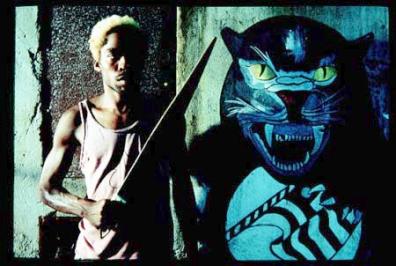Scoop Review: Carandiru
Scoop Review: Carandiru
By Yasmine Ryan
Directed by Hector Babenco
Screenplay by Hector Babenco and Victor Navas Fernando
Based on the book “Carandiru Station”, by Dr Drauzio Varella
Starring Caio Blat, Gero Camilo, Milton Goncalves, Nelson Machado, Maria Luisa Mendonca, Lazaro Ramos, Rodrigo Santoro, Luis Vasconcuelos, Ivan de Almeida, Ailton Graça, Wagner Moura, Milhem Cortaz
Screening at Auckland’s Academy theatre.
Even for the most hardened
criminals, Carandiru House of Detention, São Paulo, was a
frightening place. The hellish scenario of masses of
bodies, confined within the crumbling walls of a prison
where guards had less control over what went on internally
than the leaders of the three gangs. Technically, Carandiru
was the purgatory of the Brazilian prison system; where
prisoners not yet convicted awaited their trial, sometimes
for many years.

In his cinematic portrayal of what was Latin America’s largest house of detention (or House of Death, as it came to be known) until its destruction in 2002, Director Babenco gets beneath the unsightly skin of Carandiru and shows his audience something of its essence.
And that is what this film is about. It is not about any individual character, but rather the tapestry woven by their collected stories. It is the story of the people of Carandiru.
The film is based on a book by Dr Drauzio Varella, called “Carandiru Station.” Dr Varella worked in the prison; his voluntary services were the only medical care provided to the inmates. He battles with rudimentary equipment, severe overcrowding (7,257 inmates are housed in facilities designed to hold 3,300), and a prison culture that revolves around drug use and promiscuous sex. Of particular concern is the prison’s looming HIV epidemic.

The doctor is the spectator’s key into Carandiru, he interacts with the prisoners as only a non-partisan outsider could. He becomes a trusted confidante to many of them, and they begin to tell him their stories. Their stories offer a glimpse into the criminal world. They are not presented as innocent victims, or as soulless monsters. They are shown as being human. Each has his own worries, and each copes with the dire environment in a different way.
The prison surroundings bring mostly despair to the characters. Some of them find hope, however, and in the case of No Way (Gero Camilo) and transgender Lady Di (Rodrigo Santoro), it brings a fairytale romance.
The colour and life and occasionally even comedy of Carandiru are presented alongside its misery – Carandiru was by no means as sterile and hospital–like as many modern prisons are. Prison visiting day is a festival, where families come to picnic with their loved once. The walls of the prison are decorated with beautiful and symbolic graffiti.
The final part of the film – which focuses on the event that made Carandiru internationally infamous – is understandably much more gritty and intense. On October 2 1992, the fighting amongst the prisoners turned into riots, and they took over Carandiru Penitentiary.
Police forces were sent in to regain control. Although it took them just an hour to secure the prison, they spent the next 5 hours executing inmates. It was not self-defence: not a single member of the police was killed. 111 prisoners died. There was an average of five bullet wounds per body. Many were sitting, kneeling, or lying in their beds when they were murdered.
The theme of truth and guilt are strong in Carandiru. The film does not claim to have a monopoly on the truth, and it does not judge whom is guilty and whom is innocent. As one prisoner puts it, “The prison is not the residence of the truth.”


 Eugene Doyle: Writing In The Time Of Genocide
Eugene Doyle: Writing In The Time Of Genocide Gordon Campbell: On Wealth Taxes And Capital Flight
Gordon Campbell: On Wealth Taxes And Capital Flight Ian Powell: Why New Zealand Should Recognise Palestine
Ian Powell: Why New Zealand Should Recognise Palestine Binoy Kampmark: Squabbling Siblings - India, Pakistan And Operation Sindoor
Binoy Kampmark: Squabbling Siblings - India, Pakistan And Operation Sindoor Gordon Campbell: On Budget 2025
Gordon Campbell: On Budget 2025 Keith Rankin: Using Cuba 1962 To Explain Trump's Brinkmanship
Keith Rankin: Using Cuba 1962 To Explain Trump's Brinkmanship